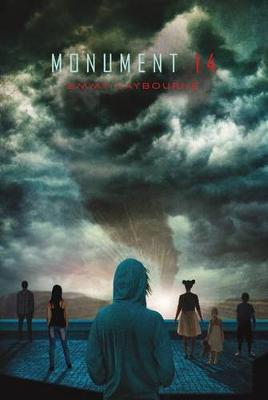Reviewed by Briana @ Pages Unbound on
Source: Publisher Twitter givewaway
Review:With a group of children sheltering in a locked superstore while the world outside falls apart, Monument 14 promises to be a thrilling read. Unfortunately, the poor writing often distracts the reader from enjoying the plot or characters. The book is narrated by teenager Dean, and his voice is oddly stilted. He, and most of the characters, use contractions only sporadically, making their dialogue sound unnatural. Additionally, Dean is the type of first-person narrator who would be more believable as a third person narrator. He is strangely omniscient and observant, even for a character who is supposed to be a writer. It is difficult to imagine a teenaged boy who says things like “I did not really save the best for last because Batiste, the lone second grader, was a real handful” (paperback 29) or “I felt gray. Washed out. Like a stone” (paperback 35). I found the writing style painful enough I was ready to DNF at page 29, but I powered through to see what the rest of the book would bring.
From the beginning, I was ready to compare Monument 14 to Danya Lorentz’s No Safety In Numbers, as both books feature groups of children trapped in stores and facing disasters. The differences between the two quickly became clear, however. Laybourne writes about a small group of children, ranging from kindergarteners to high schools, who are in a superstore riding out natural diasters. Lorentz writes about a group of teenagers stuck in a mall with a large number of other people, all of whom want to get out because the danger is inside. The dynamics are distinct in each case, as the characters must face different dangers and different fears. In common: both groups have just about everything they need to survive, ready for the picking from the stores.
In Monument 14, this convenience is actually something of a detriment on Day 1 of the children’s lock-down. At this point, the children believe they will be in the store for only an hour or so. Their school bus has crashed during a hailstorm, and several students died in the accident, but the survivors are ready to return home. As they wait for aid to arrive (again, in literally an hour), they illogically start raiding the store. Anything they want, they take (believing their parents will have to pay) and they even break into the pizza restaurant and start baking themselves pie for lunch—at their adult bus driver’s advice. I may be in the minority, but this would not be my course of action in such an emergency.
The children’s sense of logic proceeds to fluctuate wildly throughout the remainder of the book. The kindergartners will seem abnormally wise and aware, until Laybourne seems to remember their age and sends them off to suck their thumbs in a corner and cry. The older children also behave very maturely for their ages. One does expect this in a post-apocalyptic novel, where children must grow up fast, but it would be nice if they encountered more difficulties solving their numerous challenges. No water? No problem. Someone has a solution to the hygiene problem in the next paragraph and begins building the necessary structures. One boy is a boy scout, but his troop could not have prepared him with a quick solution to literally every problem he might face in a post-apocalyptic world.
Beyond the universal gift of quick-thinking, the characters range in skills and personality: the average Joe narrator, the unattainable girl he loves, the jocks, the too-young girl trying to be sexy, the generally interchangeable kindergarteners. I personally felt no connection with any them, did not like any of them, and was not particularly interested in their fates. (I had a similar reaction to No Safety in Numbers, so perhaps I just don’t like teens stuck in stores.) Laybourne tries to give most of them moving backstories, but they often seem like things that are constructed by the author and then tacked on, rather than things are actually true about the characters.
The plot is not entirely lackluster and, in fact, features an ever-growing list of catastrophes that the children must face and solve. However, the writing is off-putting enough that I did not care for the novel and will not be reading the sequel. Many other readers, of course, have much more complimentary opinions of the series.
Content Note: Light language. Mature themes including sex and attempted rape.
Reading updates
- Started reading
- 9 July, 2013: Finished reading
- 9 July, 2013: Reviewed
